Inwood, Manhattan
Inwood is a neighborhood in the New York City borough of Manhattan, at the northern tip of Manhattan Island, in the U.S. state of New York. It is bounded by the Hudson River to the west, Spuyten Duyvil Creek and Marble Hill to the north, the Harlem River to the east, and Washington Heights to the south.
Inwood | |
|---|---|
Neighborhood of Manhattan | |
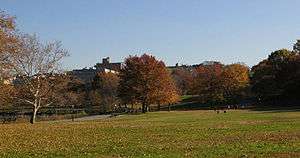 Inwood, viewed from Inwood Hill Park | |
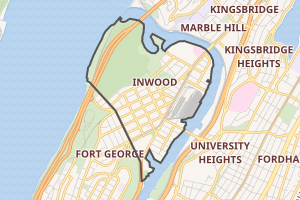
Location in New York City | |
| Coordinates: 40.867°N 73.922°W | |
| Country | |
| State | |
| City | New York City |
| Borough | Manhattan |
| Community District | Manhattan 12[1] |
| Area | |
| • Total | 3.22 km2 (1.245 sq mi) |
| Population (2016)[2] | |
| • Total | 58,946 |
| • Density | 18,000/km2 (47,000/sq mi) |
| Ethnicity | |
| • Hispanic | 72.4% |
| • White | 15.1 |
| • Black | 9.1 |
| • Asian | 1.9 |
| • Others | 1.5 |
| Economics | |
| • Median income | $49,131 |
| Time zone | UTC−5 (Eastern) |
| • Summer (DST) | UTC−4 (EDT) |
| ZIP codes | 10034, 10040 |
| Area code | 212, 332, 646, and 917 |
Inwood is part of Manhattan Community District 12 and its primary ZIP Code is 10034.[1] It is patrolled by the 34th Precinct of the New York City Police Department.
History
Colonial history
.jpg)
On May 24, 1626, according to legend,[4] Peter Minuit, the director general of the Dutch colony of New Netherland, bought the island from the Lenape Indians for 60 Dutch guilders and, the story goes, some trinkets.[5] On the southern tip of the island Minuit founded New Amsterdam. A plaque (on a rock) marking what is believed to be the spot of the sale is in Inwood Hill Park, the only natural forest left in Manhattan.
During the British occupation of Manhattan in the American Revolutionary War, there was an encampment containing more than sixty huts occupied by Hessian troops between 201st and 204th Streets along Payson Avenue. The camp was discovered in 1914 by local archeologist and historian Reginald Bolton after a series of digs around the neighborhood.[6]
19th century to present
The area between 190th and 192nd Streets was occupied by the Fort George Amusement Park, a trolley park/amusement park, from 1895 to 1914. Its site is now a seating area in Highbridge Park, which itself was laid out in the late 19th and early 20th centuries.[7]
Inwood was a very rural section of Manhattan well into the early 20th century. Once the New York City Subway's IRT Broadway–Seventh Avenue Line, the modern 1 train, reached Inwood in 1906, speculative developers constructed numerous apartment buildings on the east side of Broadway. Construction continued into the 1930s, when the IND Eighth Avenue Line, the modern A train, reached Dyckman and 207th Streets along Broadway and the large estates west of Broadway (Seaman, Dyckman, Isham, etc.) were sold off and developed. Many of Inwood's impressive Art Deco apartment buildings were constructed during this period. The area around Dyckman Street and 10th Avenue formerly contained a stadium called the Dyckman Oval, with a capacity of 4,500 spectators, which hosted football games, boxing matches, and Negro League baseball games until it was replaced by public housing in the 1950s.
The last family-owned farm in Manhattan is believed to have been in Inwood, close to the intersection of Broadway and 214th Street. It was operated by the Benedetto family and occupied an entire city block.[8] The farm site was developed after being sold in 1954,[9]
Demographics
For census purposes, the New York City government classifies Inwood as part of a larger neighborhood tabulation area called Inwood and Marble Hill.[10] Based on data from the 2010 United States Census, the population of Inwood and Marble Hill was 46,746, a change of -2,341 (-5%) from the 49,087 counted in 2000. Covering an area of 405.79 acres (164.22 ha), the neighborhood had a population density of 115.2 inhabitants per acre (73,700/sq mi; 28,500/km2).[11] The racial makeup of the neighborhood was 15.1% (7,060) White, 9.1% (4,239) African American, 0.1% (64) Native American, 1.9% (884) Asian, 0% (5) Pacific Islander, 0.4% (179) from other races, and 1% (458) from two or more races. Hispanic or Latino of any race were 72.4% (33,857) of the population.[3]
The racial composition of Inwood and Marble Hill changed moderately from 2000 to 2010, with the most significant changes being the Black population's decrease by 13% (661) and the Hispanic / Latino population's decrease by 5% (1,880). Meanwhile, the White population grew by 5% (335) and remained a minority, as with the Asian population which grew by 11% (86); the small population of all other races decreased by 24% (221).[12]
The entirety of Community District 12, which comprises Inwood and Washington Heights, had 195,830 inhabitants as of NYC Health's 2018 Community Health Profile, with an average life expectancy of 81.4 years.[13]:2, 20 This is about the same as the median life expectancy of 81.2 for all New York City neighborhoods.[14]:53 (PDF p. 84)Most inhabitants are children and middle-aged adults: 33% are between the ages of 25–44, while 25% are between 45–64, and 19% are between 0–17. The ratio of college-aged and elderly residents was lower, at 10% and 13% respectively.[13]:2
As of 2019, the median household income in Community District 12 was $42,000, compared to $73,000 in Manhattan and $53,000 in the entire city. In 2019, an estimated 25% of Community District 12 residents lived in poverty, compared to 18% in all of Manhattan and 21% in all of New York City. One in eight residents (12%) were unemployed, compared to 7% in Manhattan and 9% in New York City.[15] Rent burden, or the percentage of residents who have difficulty paying their rent, is 53% in Community District 12, compared to the boroughwide and citywide rates of 45% and 51% respectively. Based on this calculation, as of 2018, Community District 12 is considered to be gentrifying: according to the Community Health Profile, the district was low-income in 1990 and has seen above-median rent growth up to 2010.[13]:7
Trends
The residents of Inwood were substantially of Irish descent for much of the 20th century. The neighborhood exhibited a strong Irish identity with many Irish shops, pubs, and even a Gaelic football field in Inwood Hill Park. The second-largest group during this time was Jewish, an extension of the large Jewish population of Washington Heights. However, in the 1960s through the 1980s, many Irish and Jewish residents moved out to the outer boroughs (for example, Riverdale and Spuyten Duyvil in the Bronx) and the suburbs, in a pattern consistent with overall trends in the city at that time. During the same period, there was a rise in the number of Dominican immigrants to the area.
Today, Inwood has a predominantly Dominican population, especially in the areas east of Broadway; it has the highest concentration of residents of Dominican descent in New York City.[15] Hispanic residents make up 74 percent of Inwood's population as a whole, according to census data.[16] Nearly half of the residents were born outside the US.[15] A few of Irish descent remain in the blocks near the Church of the Good Shepherd at Isham Street, though even its Mass services are now offered in Spanish nearly as often as in English. The YM&YWHA remains, but the former synagogues have now been converted to churches and other uses.
Land use and terrain
Geography
Inwood is physically bounded by the Harlem River to the north and east, and the Hudson River to the west. It extends southward to Fort Tryon Park and alternatively Dyckman Street or Fairview Avenue farther south, depending on the source.[17][18]
While Inwood is the northernmost neighborhood on the island of Manhattan, it is not the northernmost neighborhood of the entire borough of Manhattan. That distinction is held by Marble Hill, a neighborhood situated just north of Inwood, on what is properly the North American mainland bordering the Bronx. Marble Hill was isolated from Inwood and the rest of Manhattan in 1895 when the route of the Harlem River was altered by the construction of the Harlem River Ship Canal.
Because of its water boundary on three sides, its hilly geography, and its limited local street connections (only Broadway and Fort George Hill connect to the rest of the Manhattan street grid), the neighborhood can feel somewhat physically detached from the rest of the borough. The W.P.A. Guide to New York City, published in the 1930s, described Inwood with "rivers and hills insulate a suburban community that is as separate an entity as any in Manhattan."[19]
Geology
Inwood marble, a soft, white, metamorphic rock found in northern Manhattan, takes its name after the neighborhood. From the mid-17th to the late 18th century, commercial quarries dotted the area as the material was used for building construction. However, due to its susceptibility to erosion, builders eventually used alternate construction materials.[20] Inwood marble was quarried for government buildings in lower Manhattan and Washington, D.C. Small pieces of marble can still be seen in the stone retaining walls around Isham Park.
The development of Inwood in the early 20th century resulted in the demolition of many rock outcroppings. However, several outcroppings still exist, including on Cooper Street between 204th and 207th Streets; at Broadway and West 216th Street; and in the garden of Holy Trinity Episcopal Church at Seaman Avenue and Cumming Street.[21] The rock on Cooper Street contains a garden maintained by a nearby housing cooperative at 60 Cooper Street, which owns half of the rock.[21][22]
The seismologically active Dyckman Street Fault runs east-west beneath the Dyckman Valley. As recently as 1989, activity of this fault caused a magnitude 2 earthquake.[23][24][25]
Land use
Commercial retail uses are mainly located along Broadway, Dyckman Street and West 207th Street. In recent years Dyckman Street west of Broadway has become a popular entertainment district with many restaurants and lounges. Offices are typically located on second floors over retail, or in the neighborhood's sole office building (a converted telephone building) at Broadway and West 215th Street. Inwood also contains one of Manhattan's few remaining C-8 zoning districts, which concentrates automotive uses on the northern stretches of Broadway.
Industrial uses, including depots for subway (207th Street Yard), bus (Kingsbridge Bus Depot), and sanitation (Manhattan North), exist primarily along Sherman Creek, an inlet of the Harlem River. The creek and surrounding industrial area is bounded by Dyckman Street to the south, Tenth Avenue to the west, and 207th Street to the north. There has been an initiative among politicians over the last few years to re-zone this area for residential and commercial use, and to create public access to the waterfront.[26] Utility company Consolidated Edison and the City of New York own some of the property in this area.
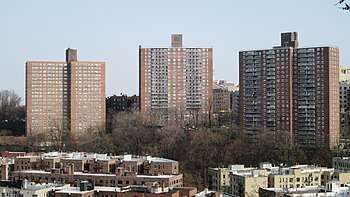
The major residential land use in Inwood is multifamily five- to eight-story prewar apartment buildings. New construction is rare. Most of the remaining detached and semi-detached houses on Manhattan Island are located in Inwood, nestled between apartment buildings. Adjacent to Sherman Creek is Inwood's public housing development, known as the Dyckman Houses and constructed in 1951.
Real estate
Inwood's real estate rents and values are sharply bifurcated between east and west. According to Manhattan Community Board 12, the districts east of Broadway are predominantly lower-income. This area is also more industrial and commercial and has fewer parks and street trees. Real estate values and rents are correspondingly lower than the area west of Broadway. Almost all of Inwood's co-ops and all of the private houses are located on the west side of Broadway.[27] According to one study in 2019, Inwood had the lowest average rents in Manhattan.[28]
In 2015, New York City began soliciting community comments on a major rezoning proposal for Inwood. The New York City Economic Development Corporation proposed to alter the area's 50-year-old current zoning plan by dividing Inwood into five sub-districts called "the tip of Manhattan", "Upland Wedge", "Upland Core", "Commercial U" and "Sherman Creek". Some of these sub-districts would be rezoned to encourage the construction of new commercial space and housing. A resident recalls being told by a city planner, "Don't think you can keep this nice neighborhood all to yourselves."[15] The rezoning proposal has triggered much feedback from the community,[29] including a sleep-in at Councilman Ydanis Rodriguez's office.[15] In August 2018, the New York City Council approved a measure to rezone the neighborhood.[30] The rezoning of Inwood allows for the construction of buildings of up to 30 stories in some areas targeted for redevelopment while introducing an 8 story height limit to many existing residential areas. Following the rezoning, over $610 million in real estate was purchased.[28]
Institutions and landmarks
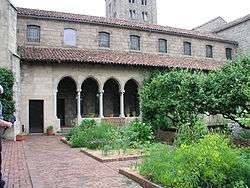
The area's best known cultural attraction is The Cloisters in Fort Tryon Park. This branch of the Metropolitan Museum of Art is devoted to Medieval art and culture, and is located in a medieval-style building, portions of which were purchased in Europe, brought to the United States, and reassembled.[31] Whether the museum itself is actually located in Inwood depends on one's definition of the neighborhood boundaries but its tower dominates the skyline of the area and the museum can be easily accessed via steep pathways leading up from Dyckman Street.
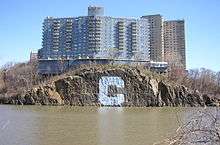
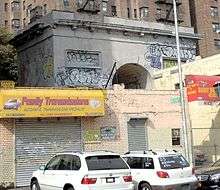
From Inwood Hill Park, one can view a 100-foot (30 m)-tall Columbia "C" painted on the face of a rock cut across the Harlem River on the Bronx shore. This collegiate logo has been in place for approximately a half-century, though it is not clear who exactly maintains the painted letter in the present day. Looking west from Inwood Hill Park across the Hudson River, one can view the New Jersey Palisades. Looking east from Inwood, the former NYU campus in University Heights, Bronx, now Bronx Community College, towers above the east end of the University Heights Bridge.
Bridges spanning Spuyten Duyvil Creek include the Henry Hudson Bridge, the longest fixed arch bridge in the world when built in 1936, and the Spuyten Duyvil Bridge, a railroad swing bridge reconstructed numerous times since originally opening in 1849. Road bridges are the Broadway Bridge and the University Heights Bridge, both important local structures.
The local hospital in Inwood is the Allen Hospital, a satellite facility of NewYork-Presbyterian Hospital.
The oldest building in Inwood is the Dyckman House, the oldest farmhouse in Manhattan, on Broadway at 204th Street. It is a New York City designated landmark.[33] Inwood has one small historic district,the Park Terrace West-West 217th Street district,[34] designated in 2018,[35]
A farmers' market takes place on Isham Street on Saturdays, year-round.
The Seaman-Drake Arch, located on Broadway at 216th Street, is one of only two free-standing arches in Manhattan, the other being the Washington Square Arch. The Seaman-Drake Arch was built in 1855 of local Inwood marble. It is the last remaining structure of the mansion that formerly stood there.[32]
At the North Cove at 207th Street and the Harlem River, both the shoreline and the water just off it have been rehabilitated from their former derelict polluted state by James Cataldi (also known as the "Birdman of Inwood") into a flourishing wetland teeming with geese, ducks, and other varieties of fowl.[36]
Parks
NYC Parks facilities
Inwood Hill Park, on the Hudson River, is a very large and old-growth forested city park. It is known for its caves that were used by the Lenape before Europeans arrived, and the last salt marsh in Manhattan.[37]:34–35 Birdwatchers come to the park to see waterbirds, raptors, and a wide variety of migratory birds. The wooded section, consisting mostly of abandoned former summer estates, features the last natural forest standing on Manhattan Island. Tennis courts, three playgrounds, a waterfront promenade and ten miles of hiking trails are also prominent components of the park.[38][39] The ballfields at 214th Street, surrounded by the land that comprises Inwood Hill Park, are considered to be part of neighboring Isham Park[40]
Isham Park sits roughly between Broadway, Isham Street, Seaman Avenue, and West 214th and 215th Streets. The park once extended to the Harlem River, but after the creation of Inwood Hill Park and the reconfiguration of area streets, the northwest boundary became, for the most part, Seaman Avenue.[40] The extent of the current park now equals that of the original Isham estate. The Isham mansion, which originally came with the park gift, was torn down in the 1940s due to its deteriorating condition.[41]
Other parks in or adjoining Inwood include Sherman Creek Park (Swindler Cove), Fort Washington Park, Fort Tryon Park, and Highbridge Park.
Columbia facilities
Columbia University's 23-acre (93,000 m2) athletic fields have been located in Inwood since the 1920s. They are known today as the Baker Athletics Complex, though locals still use the historical name of "Baker Field". The football stadium within the complex, officially Robert K. Kraft Field at Lawrence A. Wien Stadium, can accommodate 17,000 fans and was noted by Sports Illustrated as "one of the most beautiful places in the country to watch a football game" due to the scenic views of the Henry Hudson Bridge and the New Jersey Palisades from the home stands.[42]
In January 2014, a new one-acre park called Muscota Marsh opened to the public between Inwood Hill Park and Baker Field as part of an agreement with the city for the development of the Campbell Athletic Center at West 218th Street and Broadway. This waterfront park was built by Columbia and is jointly administered by the city parks department and the university.[43]
The Inwood waterfront is also home to Columbia University's Boathouse, the "1929 Boathouse". It stands next to the "Gould-Remmer Boathouse" which was originally constructed in 1895 as the Gould Boathouse at 116th Street on the Hudson River and was relocated here in 1989. This new structure now houses the Ivy League school's Crew team and hosts inter-collegiate rowing competitions.[44] In July 2018, a harbor seal nicknamed "Sealy" started showing up by the structure, garnering media attention.[45]
Community gardens
The Lt. William Tighe Triangle, aka the Riverside-Inwood Neighborhood Garden (RING), is the northernmost piece of Ft. Tryon Park and lies at the confluence of Riverside Drive, Dyckman Street, Broadway, and Seaman Avenue.[46] It is Inwood's oldest community garden, having been founded in 1984. Bruce's Garden is another notable community garden, located in the northeast corner of Isham Park.
Local newspaper
Manhattan Times is a free English / Spanish bilingual community newspaper serving Upper Manhattan, with a focus on Washington Heights and Inwood. It was founded by Luís A. Miranda Jr., Roberto Ramírez Sr., and David Keisman in 2000.[47] The print version is distributed on Wednesdays to 235 different street boxes and community organizations (as of March 2020), with over 90 locations in Inwood.[48]
The newspaper covers a variety of topics of local interest, and has played a role in promoting local restaurants, real estate, and local events alike. The newspaper has also backed many community projects such as the Bridge / Puente project in May 2006, where residents and local politicians stood together along the entire length of Dyckman Street, and the Uptown Arts Stroll, a highlight of local artists.[49]
Police and crime
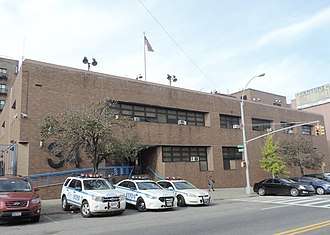
Inwood, along with Washington Heights above 179th Street, is served by the 34th Precinct of the NYPD, located at 4295 Broadway.[50] The 34th Precinct ranked 23rd safest out of 69 patrol areas for per-capita crime in 2010.[51] At one time, it was among New York City's most dangerous police precincts, largely due to its booming crack trade. However, crimes in the seven major felony categories have decreased by 87.3% between 1990 and 2019, and by 42.0% in the precinct since 1998, four years after it was split from the 33rd Precinct (Washington Heights south of 179th Street) to allow for more police presence in both precincts.[52] With a non-fatal assault rate of 43 per 100,000 people, Washington Heights and Inwood's rate of violent crimes per capita is less than that of the city as a whole. The incarceration rate of 482 per 100,000 people is higher than that of the city as a whole.[13]:8
In 2019, the 34th Precinct reported 6 murders, 22 rapes, 226 robberies, 283 felony assaults, 122 burglaries, 557 grand larcenies, and 62 grand larcenies auto.[52] Of the five major violent felonies (murder, rape, felony assault, robbery, and burglary), the precinct had a rate of 583 crimes per 100,000 residents in 2019, compared to the boroughwide average of 632 crimes per 100,000 and the citywide average of 572 crimes per 100,000.[53][54][55]
As of 2018, Community District 12 has a non-fatal assault hospitalization rate of 43 per 100,000 people, compared to the boroughwide rate of 49 per 100,000 and the citywide rate of 59 per 100,000. Its incarceration rate is 482 per 100,000 people, compared to the boroughwide rate of 407 per 100,000 and the citywide rate of 425 per 100,000.[13]:8
In 2019, the highest concentrations of felony assaults in Inwood were near the intersection of Tenth Avenue and 207th Street, where there were 12 felony assaults, and near the intersection of Tenth Avenue and 211th Street, where there were also 12. The highest concentration of robberies, on the other hand, was on Nagle Avenue between Dyckman Street and Academy Street, where there were 9 robberies in 2019.[53]
Fire safety
Inwood is served by the New York City Fire Department (FDNY)'s Engine Co. 95/Ladder Co. 36/Foam 95, located at 29 Vermilyea Avenue.[56][57]
Health
Preterm births in Community District 12 are lower than the city average, though teenage births are higher. In Community District 12, there were 73 preterm births per 1,000 live births (compared to 87 per 1,000 citywide), and 23.3 teenage births per 1,000 live births (compared to 19.3 per 1,000 citywide).[13]:11 Community District 12 has a low population of residents who are uninsured. In 2018, this population of uninsured residents was estimated to be 14%, more than the citywide rate of 12%.[13]:14
The concentration of fine particulate matter, the deadliest type of air pollutant, in Community District 12 is 0.0078 milligrams per cubic metre (7.8×10−9 oz/cu ft), more than the city average.[13]:9 Thirteen percent of Community District 12 residents are smokers, which is slightly less than the city average of 14% of residents being smokers.[13]:13 In Community District 12, 26% of residents are obese, 13% are diabetic, and 28% have high blood pressure—compared to the citywide averages of 24%, 11%, and 28% respectively.[13]:16 In addition, 24% of children are obese, compared to the citywide average of 20%.[13]:12
Eighty-one percent of residents eat some fruits and vegetables every day, which is less than the city's average of 87%. In 2018, 68% of residents described their health as "good," "very good," or "excellent," less than the city's average of 78%.[13]:13 For every supermarket in Community District 12, there are 13 bodegas.[13]:10
NewYork-Presbyterian's Allen Hospital is located in Inwood.[58][59]
Post offices and ZIP Codes
Depending on how the southern border is defined, Inwood occupies one or two ZIP Codes. The area south of Dyckman Street is in 10040 while the area north of Dyckman Street is in 10034.[60] The United States Postal Service operates two post offices near Inwood: the Inwood Station at 90 Vermilyea Avenue[61] and the Ft George Station at 4558 Broadway in Fort George (part of Washington Heights).[62]
Education
Community District 12 generally has a higher rate of college-educated residents than the rest of the city. While 38% of residents age 25 and older have a college education or higher, 29% have less than a high school education and 33% are high school graduates or have some college education. By contrast, 64% of Manhattan residents and 43% of city residents have a college education or higher.[13]:6 The percentage of Community District 12 students excelling in math rose from 27% in 2000 to 48% in 2011, though reading achievement decreased from 34% to 31% during the same time period.[63]
Community District 12's rate of elementary school student absenteeism is similar to the rest of New York City. As of 2018, 19% of elementary school students miss twenty or more days per school year, about the same as the citywide average of 20%.[14]:24 (PDF p. 55)[13]:6 Additionally, 68% of high school students in Community District 12 graduate on time, less than the citywide average of 75%.[13]:6
Schools
Public schools
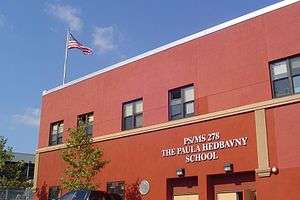
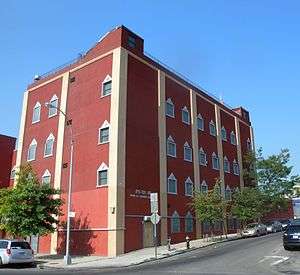
Public primary and secondary schools are provided to New York City students by the New York City Department of Education. Inwood is part of District 6, along with Washington Heights and parts of Hamilton Heights.
Zoned public elementary or elementary/middle schools include:
- PS 5 Ellen Lurie (grades PK-5)[64]
- PS/IS 18 Park Terrace (grades K-8)[65]
- PS 98 Shorac Kappock (grades PK-5)[66]
- PS 152 Dyckman Valley (grades PK-5)[67]
- Paula Hedbavny School (grades K-8)[68]
Unzoned elementary or elementary/middle schools include:
- PS 178 Professor Juan Bosch (grades K-5)[69]
- Amistad Dual Language School (grades K-8)[70]
- Muscota New School (grades K-5)[71]
- Washington Heights Academy (grades PK-8)[72]
Middle schools include:
Inwood also has the High School for Excellence and Innovation located on the corner of Academy Street and Broadway. It is a transfer school, founded in 2009 and serving grades 9 to 12.[75][76]
Charter and private schools
There is one public charter school located in Inwood: the Inwood Academy for Leadership Charter School, located on the corner of Tenth Avenue and Isham Street. It was founded in 2010 and serves grades 5 to 12.[77][78]
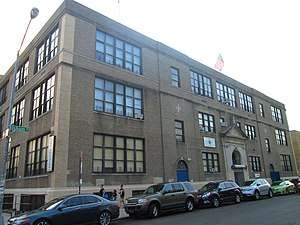
There are several private religious schools in Inwood:
- Good Shepherd School, a PK–8 Roman Catholic school
- Manhattan Christian Academy, a PK–8 nondenominational Christian school
- Northeastern Academy, a 9–12 Seventh Day Adventist high school
- Our Lady Queen of Martyrs School, a PK–8 Roman Catholic school
There is one higher-education classroom campus in Inwood:
Library
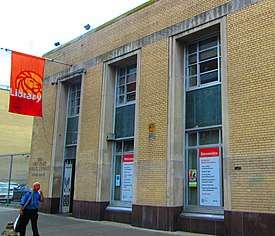
The New York Public Library (NYPL) operates the Inwood branch at 4790 Broadway. The first library in Inwood opened in 1902 as a partnership between NYPL and the Dyckman Library, and the NYPL opened several small branches in Inwood in 1923. These branches were consolidated with the opening of the current three-story branch in 1952. The Inwood branch was renovated in 2001.[79] In 2017, it was announced that a 14-story, 175-unit residential structure with a larger library would be built on the site of the Inwood branch.[80]
Transportation
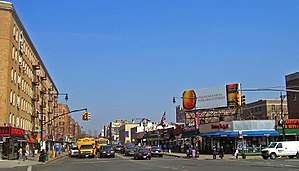
Inwood's main local thoroughfare is Broadway, which is co-designated US 9 at this point. Highway access to the area is via the Henry Hudson Parkway to the west, the Harlem River Drive to the southeast (ending at Dyckman Street), and the Alexander Hamilton Bridge over the Harlem River from the Trans-Manhattan Expressway to the Cross Bronx Expressway (both of which carry I-95 and U.S. 1). Other bridges to the area include the Washington Bridge at 181st Street, crossing the Harlem River to the Bronx; the University Heights Bridge, from 207th Street in Manhattan across the Harlem River to Fordham Road in the Bronx; the Broadway Bridge, across the Spuyten Duyvil Creek north to Marble Hill; and the Henry Hudson Bridge across Spuyten Duyvil Creek to the Bronx. Inwood's main commercial shopping streets are Broadway, Dyckman Street, and West 207th Street. Manhattan's first Slow Zone was installed on the side streets west of Broadway in 2012; it is similar to other Slow Zones citywide installed as part of Vision Zero, an initiative commenced by mayor Bill de Blasio in 2014.[81]
Public transportation
Public transportation service is provided by the Metropolitan Transportation Authority, through the New York City Subway and MTA Regional Bus Operations. The Metro-North Railroad's Hudson Line has a station just over the Broadway Bridge at Marble Hill as well as across the University Heights Bridge in University Heights.[82]
Subway
There are several New York City Subway stations in the neighborhood along two corridors: the IND Eighth Avenue Line (A train) under Broadway and the IRT Broadway–Seventh Avenue Line (1 train) above Nagle and 10th Avenues.[83][82]
- Dyckman Street (A train)
- Dyckman Street (1 train)
- Inwood–207th Street (A train), a subway terminus
- 207th Street (1 train)
- 215th Street (1 train)
_09_-_IND.jpg) Entrance to the Dyckman Street IND station on Broadway, in front of Anne Loftus Playground
Entrance to the Dyckman Street IND station on Broadway, in front of Anne Loftus Playground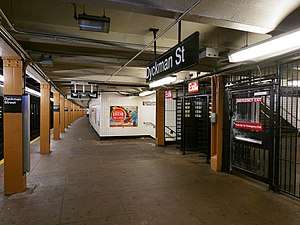 The Dyckman Street IND station's northbound exit
The Dyckman Street IND station's northbound exit- The Inwood–207th Street station
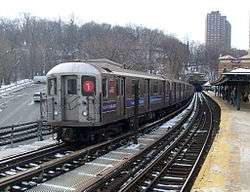 The 1 train at the elevated Dyckman Street IRT station
The 1 train at the elevated Dyckman Street IRT station- The 207th Street IRT station
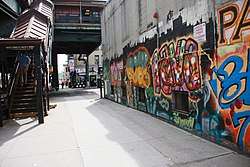 Entrance to the elevated 215th Street IRT station on 10th Avenue
Entrance to the elevated 215th Street IRT station on 10th Avenue
Bus
Inwood is also served by the following MTA Regional Bus Operations bus routes:[82][84]
- Bx7: to College of Mount Saint Vincent, Bronx via Broadway
- Bx12: to Bay Plaza Shopping Center/Orchard Beach, Bronx via 207th Street and Fordham Road–Pelham Parkway
- Bx12 SBS: to Bay Plaza Shopping Center, Bronx via 207th Street and Fordham Road–Pelham Parkway
- Bx20: to Riverdale, Bronx or Washington Heights via Broadway
- M100: to East Harlem via Broadway, Dyckman Street, and 10th Avenue
- BxM1: express to Riverdale, Bronx or Midtown Manhattan via East Side
Cycling
Bike infrastructure in Inwood is slowly expanding. Painted lanes are located on Sherman Avenue, Seaman Avenue (northbound) and the far eastern portion of Dyckman Street. Seaman Avenue (southbound) and West 218th Street are marked with sharrows (shared lane markings). A protected two-way bikeway is under construction along the central part of Dyckman Street, The Manhattan Waterfront Greenway can be accessed from Inwood on both the Hudson and Harlem River sides; in addition, a 0.75-mile (1.21 km) dead-end stub along the Hudson waterfront below Dyckman Street was added in 2014. Technically, there is a ban on bicycles in Inwood Hill Park except for its western edge and the Henry Hudson Bridge. The Broadway Bridge is undergoing a multi-year rehabilitation, which will include the addition of bike lanes.[85]
Notable residents
Notable current and former residents of Inwood include:
- Kareem Abdul-Jabbar (born 1947), former NBA basketball star, grew up in the Dyckman Houses as Lew Alcindor.[86]
- Jim Carroll (1950–2009), author of The Basketball Diaries, an autobiography set in 1960s Inwood which was adapted into a film in 1995 starring Leonardo DiCaprio.[87]
- Jack Gore (born 2005), actor who is best known for his protagonist role as Timmy Cleary in ABC’s The Kids Are Alright.[88]
- Wynn Handman (born 1922), Artistic Director of The American Place Theatre.[89]
- Bess Houdini (1876–1943), wife of magician and stunt performer Harry Houdini, lived at 67 Payson Avenue and conducted seances to contact him after his death.[90]
- Brian Lehrer (born 1952), radio host on WNYC.[91]
- Lionel Mapleson (1865–1937), violinist and librarian of the Metropolitan Opera House for nearly 50 years. Creator of the Mapleson Cylinders, one of the earliest recordings of live classical music. Mapleson lived on Park Terrace East at the time of his death.[92]
- Anthony Marx, president and CEO of the New York Public Library.[93]
- Lin-Manuel Miranda (born 1980), actor and writer of the Broadway musicals In the Heights and Hamilton.[94]
- Paul Stanley (born 1952), musician and co-founder of the American rock band Kiss, was born in Inwood and lived in the neighborhood until age 8.[95]
- Henry Stern (born 1935), longtime former Commissioner of the New York City Department of Parks and Recreation.[96]
- Isidor Straus (1845–1912), owner of Macy's department store, owned a country estate that was located in present-day Inwood Hill Park[97]
- JULIO 204, early graffiti writer and resident 204th street, inspiration for TAKI 183[98]
References
- "NYC Planning | Community Profiles". communityprofiles.planning.nyc.gov. New York City Department of City Planning. Retrieved March 18, 2019.
- "Inwood neighborhood in New York". Retrieved March 18, 2019.
- Table PL-P3A NTA: Total Population by Mutually Exclusive Race and Hispanic Origin - New York City Neighborhood Tabulation Areas*, 2010, Population Division - New York City Department of City Planning, March 29, 2011. Accessed June 14, 2016.
- "Where Did the Manhattan 'Purchase' Take Place?," New Netherland Institute
- ""Peter Minuit," Britannica Online". Encyclopædia Britannica. Retrieved October 28, 2014.
- "Archived copy". Archived from the original on July 23, 2011. Retrieved March 21, 2011.CS1 maint: archived copy as title (link)
- Martens, Victoria (August 1, 2019). "Fort George Amusement Park". Museum of the City of New York. Retrieved September 2, 2019.
- Kilgannon, Corey (November 27, 2019). "After 240 Years and 7 Generations, Forced to Sell the Family Farm". The New York Times. ISSN 0362-4331. Retrieved November 29, 2019.
- Leadon, F. (2018). Broadway: A History of New York City in Thirteen Miles. W. W. Norton. p. 379. ISBN 978-0-393-28545-1. Retrieved November 29, 2019.
- New York City Neighborhood Tabulation Areas*, 2010, Population Division - New York City Department of City Planning, February 2012. Accessed June 16, 2016.
- Table PL-P5 NTA: Total Population and Persons Per Acre - New York City Neighborhood Tabulation Areas*, 2010, Population Division - New York City Department of City Planning, February 2012. Accessed June 16, 2016.
- "Race / Ethnic Change by Neighborhood" (Excel file). Center for Urban Research, The Graduate Center, CUNY. May 23, 2011. Retrieved March 20, 2020.
- "Washington Heights and Inwood" (PDF). nyc.gov. NYC Health. 2018. Retrieved March 2, 2019.
- "2016-2018 Community Health Assessment and Community Health Improvement Plan: Take Care New York 2020" (PDF). nyc.gov. New York City Department of Health and Mental Hygiene. 2016. Retrieved September 8, 2017.
- Mays, Jeffrey C., "Before Rezoning Vote, Residents Ask: 'Where Will We Go?'," The New York Times, Aug. 8, 2018, A17.
- Beyer, Gregory (March 1, 2009). "Northern Zone, South-of-the-Border Flavor". The New York Times.
- Jackson, Nancy Beth. "If You're Thinking of Living In/Inwood; Away From Manhattan Without Leaving", The New York Times, December 15, 2002. Accessed October 23, 2008. "The neighborhood's southern boundary with Washington Heights depends on who's defining. Residents line up in two camps: Fairview Avenue as described in the Encyclopedia of New York City and Dyckman Street( Most Common), about a half-dozen blocks to the north, on Department of City Planning maps. Real estate agents seem to agree with the encyclopedia."
- Russo, Francine. "Close Up On: Inwood", The Village Voice, October 15, 2002. Accessed October 23, 2008. "Boundaries: Fairview Avenue to the south, Dyckman Street to the west, and the Harlem River to the north and east (Inwood is bisected by Broadway)."
- Federal Writers' Project (1939). "New York City Guide". New York: Random House. pp. 302–306. ISBN 978-1-60354-055-1. (Reprinted by Scholarly Press, 1976; often referred to as WPA Guide to New York City.)
- Archived December 25, 2011, at the Wayback Machine "Secrets of New York" Podcast, "Facelift: Inwood Hill, Harlem River Ship Canal, Secret of Marble Hill Episode"
- Sohn, Amy (September 20, 2019). "How a Paleozoic Rock Became a $3 Million Real Estate Prospect". The New York Times. ISSN 0362-4331. Retrieved September 27, 2019.
- "A Giant Rock Outcropping in Northern Manhattan is For Sale for $3 Million". Untapped Cities. September 24, 2019. Retrieved September 27, 2019.
- Fennell, Ryan (November 30, 1989). "Could It Happen Here? Earthquakes In The Tri-State Area". Two River Times. Archived from the original on July 19, 2011.
- Sykes, Lynn R.; et al. (August 2008). "Observations and Tectonic Setting of Historic and Instrumentally Located Earthquakes in the Greater New York City–Philadelphia Area" (PDF). Bulletin of the Seismological Society of America, Vol. 98, No. 4, pp. 1696–1719.
- Shahid, Alihay (March 17, 2011). "Could an earthquake hit New York City? History says yes, but not like 9.0 magnitude Japan earthquake". New York Daily News.
- "Sherman Creek initiative at nyc.gov". Archived from the original on October 18, 2014. Retrieved October 28, 2014.
- "Archived copy" (PDF). Archived from the original (PDF) on November 3, 2012. Retrieved April 7, 2013.CS1 maint: archived copy as title (link)
- Haag, Matthew (September 27, 2019). "It's Manhattan's Last Affordable Neighborhood. But for How Long?". The New York Times. ISSN 0362-4331. Retrieved September 28, 2019.
- Pichardo, Carolina (July 20, 2017). "5 Takeaways From the Inwood Rezoning Proposal". DNAinfo. Archived from the original on October 8, 2017. Retrieved October 5, 2018.
- Walker, Ameena (August 8, 2018). "Inwood rezoning will move forward with City Council approval". Curbed NY. Retrieved October 5, 2018.
- "The Cloisters Museum and Gardens". The Metropolitan Museum of Art. Retrieved May 15, 2016
- "The Inwood Arch and Mansion: Circa 1896". myinwood.net. Retrieved June 1, 2015.
- "Dyckman House" (PDF). New York City Landmarks Preservation Commission. July 12, 1967. Retrieved December 6, 2019.
- "Park Terrace West – West 217th Street Historic District" (PDF). New York City Landmarks Preservation Commission. December 11, 2018. Retrieved December 6, 2019.
- Walker, Ameena (December 11, 2018). "Inwood enclave of early 20th-century homes is NYC's newest historic district". Curbed NY. Retrieved January 16, 2020.
- "Bird Week | 'Birdman' of Inwood". May 4, 2011.
- Eldredge, Niles & Horenstein, Sidney (2014). Concrete Jungle: New York City and Our Last Best Hope for a Sustainable Future. Berkeley, California: University of California Press. ISBN 978-0-520-27015-2.
- "Inwood Hill Park". New York City Department of Parks and Recreation. Retrieved July 26, 2009.
- Yarrow, Andrew L. (May 1, 1987). "Exploring Inwood Hill's Urban Wilderness". The New York Times. ISSN 0362-4331. Retrieved September 28, 2019.
- "Isham Park" New York City Geographic Information System map
- "Isham Park - Historical Sign". New York City Department of Parks and Recreation. Retrieved July 19, 2010.
- "Columbia Athletics" Archived May 24, 2011, at the Wayback Machine.
- Foderaro, Lisa W. (January 20, 2014). "With University's Help, New Park on Harlem River Is a Marshland Sanctuary". The New York Times. Retrieved February 10, 2014.
- "Columbia Rowing Boathouses". Columbia University Athletics.
- "Lonely Seal Becomes Local Celebrity in Upper Manhattan". NBC New York.
- "RING Garden". RING Garden. Retrieved October 28, 2014.
- "ABOUT US - Manhattan Times News". www.manhattantimesnews.com. Retrieved March 25, 2020.
- "GET THE PAPER - Manhattan Times News". www.manhattantimesnews.com. Retrieved March 25, 2020.
- Luís A. Miranda Jr. and Roberto Ramírez Sr. (March 18, 2020). "Uptown United" (PDF). Manhattan Times. 21 (12). New York City. Retrieved March 25, 2020.CS1 maint: uses authors parameter (link)
- "NYPD – 34th Precinct". www.nyc.gov. New York City Police Department. Retrieved October 3, 2016.
- "Inwood – DNAinfo.com Crime and Safety Report". www.dnainfo.com. Archived from the original on December 30, 2016. Retrieved October 6, 2016.
- "34th Precinct CompStat Report" (PDF). www.nyc.gov. New York City Police Department. Retrieved March 14, 2020.
- "NYC Crime Map". www.nyc.gov. New York City Police Department. Retrieved March 23, 2020.
- "Citywide Seven Major Felony Offenses 2000-2019" (PDF). www.nyc.gov. New York City Police Department. Retrieved March 23, 2020.
- "Citywide Seven Major Felony Offenses by Precinct 2000-2019" (PDF). www.nyc.gov. New York City Police Department. Retrieved March 23, 2020.
- "Engine Company 95/Ladder Company 36/Foam 95". FDNYtrucks.com. Retrieved March 14, 2019.
- "FDNY Firehouse Listing – Location of Firehouses and companies". NYC Open Data; Socrata. New York City Fire Department. September 10, 2018. Retrieved March 14, 2019.
- "Manhattan Hospital Listings". New York Hospitals. Retrieved March 20, 2019.
- "Best Hospitals in New York, N.Y." US News & World Report. July 26, 2011. Retrieved March 20, 2019.
- "Inwood, New York City-Manhattan, New York Zip Code Boundary Map (NY)". United States Zip Code Boundary Map (USA). Retrieved March 26, 2019.
- "Location Details: Inwood". USPS.com. Retrieved March 7, 2019.
- "Location Details: Fort George". USPS.com. Retrieved March 7, 2019.
- "Morningside Heights/Hamilton – MN 06" (PDF). Furman Center for Real Estate and Urban Policy. 2011. Retrieved October 5, 2016.
- "P.S. 5 Ellen Lurie". New York City Department of Education. Retrieved April 8, 2020.
- "P.S./I.S. 18 Park Terrace". New York City Department of Education. Retrieved April 8, 2020.
- "P.S. 98 Shorac Kappock". New York City Department of Education. Retrieved April 8, 2020.
- "P.S. 152 Dyckman Valley". New York City Department of Education. Retrieved April 8, 2020.
- "Paula Hedbanvy School". New York City Department of Education. Retrieved April 8, 2020.
- "Professor Juan Bosch Public School". New York City Department of Education. Retrieved April 8, 2020.
- "Amistad Dual Language School". New York City Department of Education. Retrieved April 8, 2020.
- "Muscota". New York City Department of Education. Retrieved April 8, 2020.
- "Washington Heights Academy". New York City Department of Education. Retrieved April 8, 2020.
- "P.S. 52". New York City Department of Education. Retrieved April 8, 2020.
- "M.S. 322". New York City Department of Education. Retrieved April 8, 2020.
- "High School for Excellence and Innovation". New York City Department of Education. Retrieved April 8, 2020.
- "High School for Excellence and Innovation District 6 – InsideSchools". insideschools.org. Retrieved April 8, 2020.
- "Inwood Academy for Leadership Charter School". New York City Department of Education. Retrieved April 8, 2020.
- "About – Inwood Academy". inwoodacademy.org. Retrieved April 8, 2020.
- "About the Inwood Library". The New York Public Library. Retrieved March 23, 2019.
- Warerkar, Tanay (March 7, 2018). "Inwood Library redevelopment will create 175 affordable apartments". Curbed NY. Retrieved March 26, 2019.
- Carla Zanoni (June 11, 2012). "Inwood Traffic Could Put on the Brakes Under Neighborhood Slow Zone". DNAInfo. Archived from the original on November 9, 2014. Retrieved October 27, 2014.
- "Manhattan Bus Map" (PDF). Metropolitan Transportation Authority. December 2017. Retrieved April 24, 2018.
- "Subway Map" (PDF). Metropolitan Transportation Authority. October 21, 2019. Retrieved January 18, 2018.
- "Bronx Bus Map" (PDF). Metropolitan Transportation Authority. September 2017. Retrieved April 24, 2018.
- "NYC DOT - Bicycle Maps" (PDF). nyc.gov. New York City Department of Transportation. 2019. Retrieved May 14, 2019.
- New York Magazine."Childhood in New York". Accessed June 16, 2015.
- Entertainment Weekly. "Jim Carroll Cool Poet". Accessed March 24, 2008.
- Pichardo, Carolina. "Inwood Siblings Launch Detective Agency to Solve Neighborhood Mysteries" Archived December 8, 2019, at the Wayback Machine, DNAinfo, March 4, 2016. Accessed December 8, 2019. "Inwood — Nancy Drew and the Hardy Boys have nothing on these kid detectives. Siblings Jack Gore, 10, and Phoebe Gore, 7, founders of the Gore & Gore Detective Agency, already have three solved cases under their belt."
- Ryzik, Melena. "Nearly 60 Years and Counting, Working on the Art of Theater", The New York Times, May 20, 2007. "He grew up in Inwood, on a dirt road, fishing for crabs off a dock on Dyckman Street. "I had a country boyhood in Upper Manhattan," he said."
- "Reports Message Of Houdini Decoded; Widow Says Medium In Trance Gave Key Words Left By The Magician. Hundreds Made Tests But She Is Convinced, She Suys, That Arthur Ford Was In Touch With Husband. Miss Pelton-Jones's Recital." The New York Times, January 9, 1929. Accessed December 8, 2019.
- Ungar-Sargon, Batya. "Hello, Brian Lehrer? This Is All of New York On the Line.The longtime host of NPR flagship WNYC’s morning call-in show talks about being a radio mensch, Rush Limbaugh, and city politics", Tablet (magazine), July 5, 2013. Accessed January 28, 2017. "Born in Queens to parents from the South Bronx who met in high school, Lehrer, 60, now lives in Inwood with his wife and two kids."
- "Lionel S. Mapleson, Opera's Librarian; Served Metropolitan Nearly Half Century-Victim Of Heart Attack At 72 Friend Of Great Singers Maintained Large Collection Of Music Which He Sent Out on Loan to Orchestras Son of Opera Librarian Helped Many Singers", The New York Times, December 23, 1937. Accessed December 8, 2019.
- NYPL. .
- Melena Ryzik. "Heights before Broadway". The New York Times. Accessed March 24, 2008.
- Oliveri, Kristen. "KISS' Stanley, Simmons Unveil Restaurant Chain Expansion", The Daily Meal, January 20, 2005. Accessed January 28, 2017. "Stanley was born in the Inwood neighborhood of Manhattan in New York City to a German mother and a first-generation Polish father who made sure the family understood the value of a decent meal."
- Bumiller, Elisabeth. "Guarding the Turf, Stepping on Toes; Henry Stern, Passionate and Blunt, Champions the City Parks", The New York Times, July 23, 1995. Accessed December 8, 2019. "There are a few other key things that define Mr. Stern. He grew up in Inwood, a mixture of Jewish, Irish and Greek immigrants several generations ago but now a largely Dominican neighborhood."
- Yarrow, Andrew L. "Exploring Inwood Hill's Urban Wilderness", The New York Times, May 1, 1987. Accessed January 28, 2017. "Isidor Straus, the founder of Macy's who died on the Titanic, built a huge house some 200 feet above the Hudson; the site is now a meadow where lilacs and privets grow, and a few ruined walls from the estate are clad with vines. In the early 1900s, the area was dotted also with various hospitals, asylums and homes for 'wayward' girls."
- Austin, Joe (2001). Taking the Train: How Graffiti Art Became an Urban Crisis in New York City. Columbia University Press. p. 46. ISBN 9780231111423.